
Solaris by A.Tarkovsky: Music-Visual Troping, Paradigmatism, Cognitive Stereoscopy
Abstract
The article considers signification processes in Solaris by the legendary film-maker A. Tarkovsky. The narration of the film is codified with the musical and visual set of quotations: it includes texts, which belong to non-cinematic arts. The process of comprehension runs as a reflection of one image in another one or refraction of one image through another. By this accumulation of metaphors there comes the multidimensional vision of a subject and the narrative reality doubles and trebles. The quotations build up the fundamental cognitive textual channel of the film, which unfolds independently in parallel and through the main film narration. The investigation follows the crossing points of the diachronical musical and visual textual chains and synchronises the meaning of the musical and visual metaphors.
On creating his masterpiece Solaris (1972), the legendary Russian film-maker Andrei Tarkovsky coded the narration with the inter-circulation of texts, belonging to diverse non-cinematic art-realities: music and painting. These citations mark the most significant moments of the film. Tarkovsky’s cinematic technique represents his ability to reflect the meaning with the help of metaphorisation and to set up a multidimensional vision of a subject. My proposal is to consider the signification processes in Solaris in musical-visual episodes. I shall point out the criss-cross of the diachronical musical and visual chains and shall try to synchronise them.
On Reviewing the Plot
The film is based on a science fiction, one of the most well-known novels written by the Polish XX-century writer, - Stanislaw Lem (1961)[1]. Solaris is a planet covered by a thinking substance, resembling a Living Ocean. The study of Solaris is nearly closed after current problems at the station. The situation seems to run beyond control. Three scholars living at the station have investigated Solaris and got a sudden feedback from it. Solaris has also started its investigations about people and their world, examining human consciousness and penetrating through people's thoughts and memories. Then the strange guests appear at the station, destined for and linked personally to each scholar. The guests are creations of the consciousness, from which Solaris has derived them and then materialized. They are all connected with personal memories, reflections, mistakes, guilt and humanity.
Despite of the formalities of the science fiction genre[2], here, the plot is deliberately weakened. The science fiction is merely a context for the author to introduce deep reasoning about human life, relationship between people and relations with the world. In fact, it is also a study about existence and non-existence.
Solaris presents a love-story, which is at the central position. It is traced to the past of the protagonist Kris Kelvin, a psychologist, sent to Solaris to inspect the situation. His personal guest is his wife Hari, died long ago: after Kris had broken up she made a suicide. He feels guilty and responsible for it. At Solaris Hari is a strange phenomenon, she is neither alive nor revived; being somewhat a representation of Hari’s image. Her memory about her earth life is partial but, on learning human existence, she remembers more and more, and Solaris cognizes human reality with her.
Tarkovsky's Music-and-Sound Aesthetics
Tarkovsky’s sound conception reveals in a small essay on music and noise in his book Sculpting in Time (Tarkovsky, 1989). The following issues are important for my further investigations:
I find music in film most acceptable when it is used like a refrain. When we come across a refrain in poetry we return, already in possession of what we have read, to the first cause which prompted the poet to write the lines originally. The refrain brings us back to our first experience of entering that poetic world, making it immediate and at the same time renewing it. We return, as it were, to its sources. […]
With the introduction of the musical progression, the life recorded in the frame can change its colour and sometimes even its essence. (p. 158)
But music is not just an appendage to the visual image. It must be an essential element of the realisation of the concept as a whole. Properly used, music has the capacity to change the whole emotional tone of a filmed sequence; it must be so completely one with the visual image that if it was to be removed from a particular episode, the visual image would not just be weaker in its idea and its impact, it would be qualitatively different. (p.158-159)
I should like to hope that it [music] has never been a flat illustration of what was happening on the screen, to be felt as a kind of emotional aura around the objects shown, in order to force the audience to see the image in the way I wanted. In every instance, music in cinema is for me a natural part of our resonant world, a part of human life. (p.159)
I have to say that in my heart of hearts I don’t believe films need music at all. However, I have not yet made a film without it, though I moved in that direction in Stalker and Nostalgia…. For the moment at least music has always had a rightful place in my films, and has been important and precious. […]
Nevertheless, it is quite possible that in a sound film that is realised with complete theoretical consistency, there will be no place for music: it will be replaced by sounds in which cinema constantly discovers new levels of meaning. […]
It may be that in order to make the cinematic image sound authentically, in its full diapason, music has to be abandoned. For strictly speaking the world as transformed by cinema and the world as transformed by music are parallel, and conflict with each other. Properly organised in a film, the resonant world is musical in its essence – and that is the true music of cinema.
Above all, I feel that the sounds of this world are so beautiful in themselves that if only we could learn to listen to them properly, cinema would have no need of music at all. (p. 159-162)
Electronic music seems to me to have enormously rich possibilities for cinema. […] The moment we hear what it is, and realise that it’s being constructed, electronic music dies. […] Electronic music must be purged of its ‘chemical’ origins, so that as we listen we may catch in it the primary notes of the world.
Instrumental music is artistically so autonomous that it is far harder for it to dissolve into the film to the point where it becomes an organic part of it. Therefore its use will always involve some measure of compromise, because it is always illustrative. Furthermore, electronic music has exactly that capacity for being absorbed into the sound. It can be hidden behind other noises and remain indistinct. (p. 162-163)
Generally speaking, the soundtrack is positioned according to its interrelations with other entities of the film continuum, in two steps: 1) regarding another sound representation, such as the speech episodes, and 2) regarding the visuals. On the one hand, in contrast to most of film productions, Tarkovsky’s soundtracks do not accompany the narratives continuously. He introduces an essential sound space, where dialogues run slowly and are free of musical investments that makes the appearance of sound episodes extraordinary events. Sound becomes a sort of commentary and reasoning for the whole film, which only has a sense if completed with a great deal of pauses. Thus, the sound relationship within a film includes such opposite categories as sound and non-sound.
On the other hand, the soundtracks are meant to be a part of the film body and correlate to the visuals. The musical sequences used without the visuals would lose the plenitude. The same could be said about the images on screen viewed without music. Tarkovsky is an artist, who narrates by images and by interplay of images[3]; that means the relevant moments are usually marked with the special strategy:
- The appearance of the in-built non-cinematic texts: for instance a quotation from painting or music, reference to it or, in some cases, reminiscence.
- The remarkable interaction of the visual and sound (musical) images of the film that discovers crossing signification processes, and semantically builds up the associative but not evident links between objects.
The Sound Space in Solaris
Music in Solaris appears for polyphony with the visuals but does not accompany the speech interactions. Factually, the soundings nearly always can be taken as diegetic, on following Tarkovsky’s sound logic. Generally, the soundscape might hardly be considered as music, but rather as sounding. It comes as completely heterogeneous construct, created from different sound realities: natural sounds, urban noise and cosmic environmental sound, with the only real musical sample, a quotation from J.S.Bach, which becomes the most important musical paradigmatic event running across the film. All the sound realities are listed and analysed below in order to discern their relationship with each other and with the images they correspond to:
- The natural sounds, such as birds, rain storm and flowing water[4] correlate to the episodes in the earth. Thus, the film starts in the countryside, where Kris is visiting his father. These sounds also appear during recollection of some episodes of Kris’ past while he is at Solaris. These kinds of sounds represent the genuine world of the Earth, its memory and humanity.
- The urban noise, which appears only once, in the episode of driving a car through a megapolis, represents the modern culture. However, it might be read as a transitional sound between displays of the Earth and displays of Solaris.
- The cosmic environmental sound takes place in different moments and provides a kind of diversity but generally symbolises the presence of Solaris: it might be, then, interpreted as a sound of universe. One sound of this set serves a leitmotiv of the guests and accompanies the appearances of Hari.
- The quotation of Bach, the Choral prelude in f-minor (Ich ruf’ zu Dir, Herr Jesu Christ, BWV Anh. 73-2.58, a variant of the famous prelude BWV 639 from the Little Organ Book of V.F.Bach) sounds in the film four times and reflects the global idea of the Earth as an image for Solaris.
The whole sound space, therefore, might be seen as a combination of silence, concrete sounds (natural and technical), cosmic sounds, represented by electronic music, and Bach’s score.
The Bach and the Bruegel
The two basic paradigms of Solaris, musical and visual, introduce the aesthetic strategy of troping: they are the already mentioned Choral Prelude and P.Bruegel the Elder’s landscape, The Hunters in the Snow (1565). The latter, together with a couple of other associative images from painting, collaborates with Bach’s topic. The evidence of their importance reveals through the fact of their constant re-appearance across the film. They are refrains, speaking in Tarkovsky’s terms. Bach’s Prelude sounds four times, starting from the main title:
- The first quotation appears quite surprisingly, thus, causing the breach of a cliché: Bach as the opening theme, over the black screen with the slowly running titles, is something, which makes audience suspicious when watching a science fiction. It does not give a clue.
- The second time it comes during recollections, when Kris and Hari are watching an old video brought from the Earth. This is quite an interesting case to be observed in details: the video is combined with music, where the change of images is synchronized with the musical tempo and rhythm, thus, designing a clip. It mixes up different seasons and times, though images are mostly from Kris’ childhood, which is an important localisation of his memory. It shows him in his youth and adulthood, his father, his mother and Hari. This musical episode bears a link to painting: the image of the mother with a little dog in her hands certainly refers to Lady with an Ermine by Leonardo da Vinci.
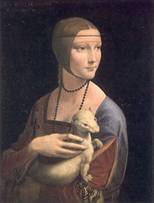 |
 |
| Picture 1: Lady with an Ermine. |
Picture 2: Mother with a dog. |
Here Bach’s tune runs as a diegetic one, the synchronisation of the musical and video events suggests that the music comes from the video. Bach is generated from the sound of Solaris, and repeatedly crossed with birds’ singing and steps on the snow, belonging to the visuals on screen. Table 1 figures out the coordination and relationship of the sound and visuals in that case[5].
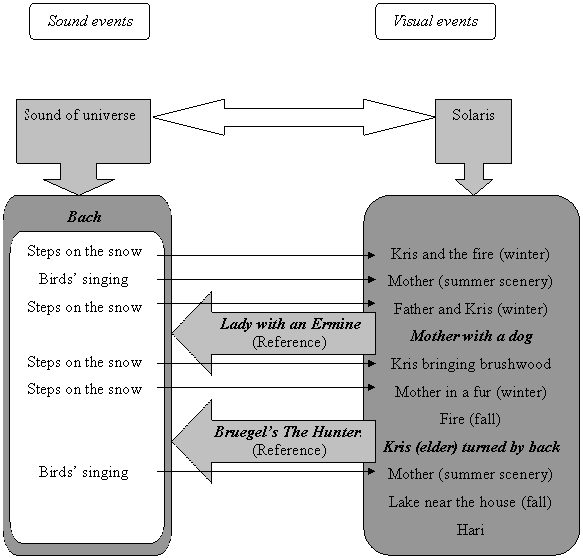
Table 1: The music-visual synchronisation of the first episode.
- The Prelude sounds for the third time in the long culmination episode in the library: the scene contains the extract of the most important images and sounds of the film.
- The last case of the quotation belongs to the ambiguous, metaphorically organized finale: a return home as a new phantom of Solaris.
Bruegel’s landscape is shown few times, as well:
- The painting appears during the sequence of library scenes at least three times, that makes it a significant and attractive object.
- The painting is taken into Kris’ dream, which he gets during his disease: on being in a fever he sees himself coming to his mother; for a moment the landscape serves as a background.
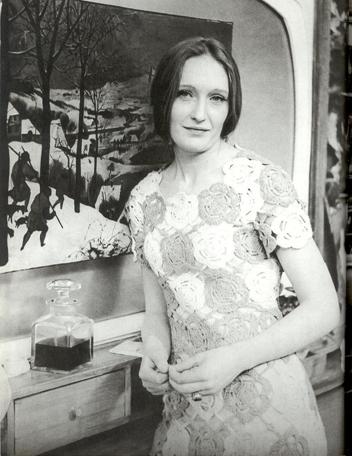 |
| Picture 3: Mother with the painting. |
Both Bach and Bruegel are concentrated at the golden section and the end of the film: they convey the Earth and humanity in eternal images. Bach could be considered as the inclusive representation of the earth and humanity for Solaris: three times the Prelude is quoted in Solaris’ episodes.
Commonly, in church practice the tune was used in the parts of prayer service devoted to the life and sufferings of Jesus Christ. Thus, it translates the values of the humankind through the image of Christ-human. Since the Prelude implies the idea of God, it is an address to the universe, which might be Solaris.
Bach and Bruegel are regarded as memory of ages and the world, but also they belong to Kris's memory and correspond to his video, which is exactly a representation of his memory. Bach is originally related to the video; as to Bruegel, the painting gives strong connotations to the motives of his old video, as I put below. All leitmotivs of the film, such as The Hunters, Bach, rain and flowing water, mother, home are personal paradigms of memory: they are the codes to read Kris Kelvin, hence, Solaris is reading them, accordingly.
The Music-visual Synchronisation
The two last scenes, which include Bach’s Prelude, are crossing points of the film, where the meaning comes out through a very intensive and complicated multileveled intertextual circulation: all important symbols, paradigms and quotations are joined there and the objects of different artistic realities are to uncover associative links. Tarkovsky explained his strategy as poetic logic and poetic links (Tarkovsky, 1989, pp. 18-22, 29-31), where he meant poetry not as a literary genre but as a specific attitude to reality, the philosophy, becoming the way of life.
With the use of the poetic logic, the building-up principle shifts from one constituent to another. The aesthetic position by Tarkovsky implies that the poetic logic is closer to the patterns of thinking and to everyday reception of reality. He relates this phenomenon to the attributes of human memory and distinguishes that some sides of human life, like dreams and recollections, could not be represented otherwise than by means of poetry.
The library episode with Bach starts with Hari looking at Bruegel’s landscape and recollecting young Kris from the video. He is at the very point, which is the perspective to see Bruegel’s landscape: at the top of a snow-covered hill, with his back half-turned, the same posture as of the hunters, he is observing the landscape below. And this is the way to see another allusion to the painting.
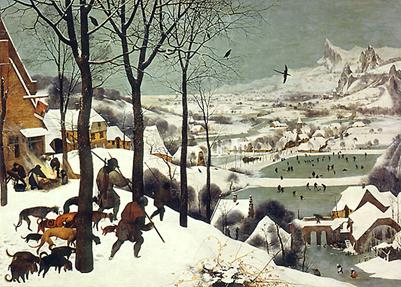 |
| Picture 4: Bruegel’s The Hunters on the snow. |
Tarkovsky applied an exciting strategy to Bruegel, which can be regarded as a discovery and which we can call actuation of painting. He fragments the landscape and takes it panoramically with the moving camera, like a cameraman would film a real landscape from a distant point. With this segmentation every take of the picture, even the farthest one, appears as a close-up. More than that, the images get moving: a bird from the landscape becomes animated. The experiment also concerns the sound, since Tarkovsky made the fragmented images and sounds correlate.
Musically the episode starts with the human voices, which are heard a bit before the painting appears on the screen. When the painting is seen the human and dog’s voices correspond with images of people, dogs and a village; birds’ voices - with the birds’ images; church bell’s sound – with the appearance of the church; calls or signals - with the Hunters. The sound makes the picture acting, it seems a sounding video. The invisible observer is at the point of the Hunters. And after all that, it gives the clue: the landscape of the old video with small Kris accompanied by birds’ voices.
This metaphysical commentary to the landscape is followed by even more metaphysical episode of weightlessness, complemented with the sound of Bach. There is a strong associative link, to be distinguished. It is mediated by painting - the actuation of Marc Chagall’s soaring lovers, even with some typical details from his pictures, such as a motive of candle light.
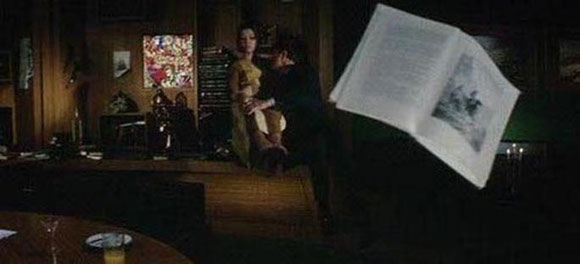 |
|
| Picture 5: Weightlessness. | |
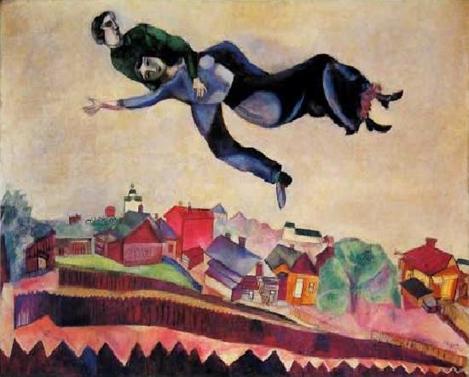 |
|
| Picture 6: Chagall’s Au Dessus de la Ville. | |
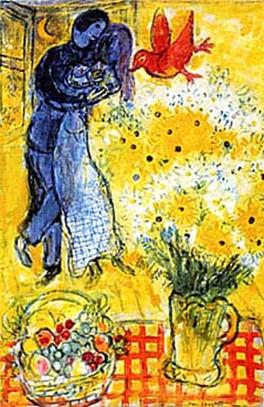 |
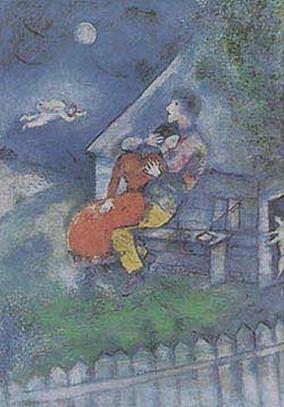 |
| Picture 7: Chagall’s Les Amoureux aux Marguerites. | Picture 8: Chagall’s The Lovers. |
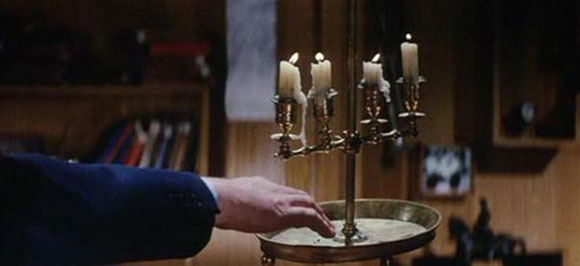 |
|
| Picture 9: Candle. | |
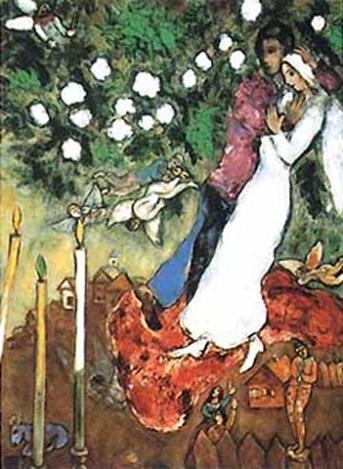 |
|
| Picture 10: Chagall’s Three Candles. | |
This case deals with quite a reverse strategy: while Bruegel was brought to dynamical observation, put into motion, with Chagall the acting is seen as coming to a static position, so to say, a sort of meditation. Finally, an illustration from the open book of Don Quixote, which is floating beside the Lovers, takes part in the informative interchange. Now Bach tune is unfinished, stopped suddenly with the sound of breaking thermos (Hari’s attempt of suicide). In the visual context of the episode Bach embraces an evident connotative meaning: it becomes the representation of love. In essence, the semantic field of the other two scenes with Bach’s quotation does not negate this meaning: the love is uncovered in broad sense as the fundamental inherent only to the human world and preached by Christ, as the essential principle, by which the world is held up and which rules over the human relations.
The Table 2 shows the sequence of the visual and musical events within the scene and their temporal synchronism (shown in the order of their appearance and correspondence). It can be seen that nearly all musical realities of the film (the three basic ones) cross here, such as natural and cosmic sounds and Bach’s quotation:
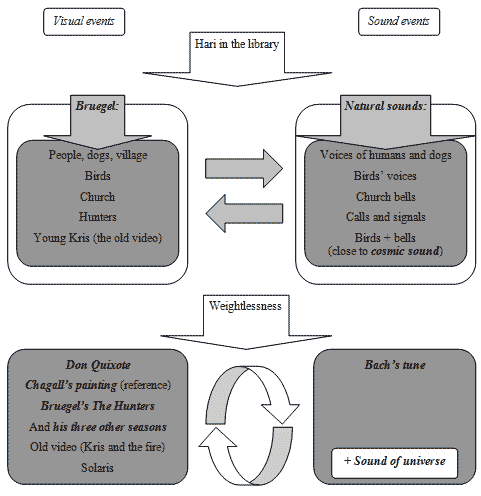
Table 2: The music-visual synchronisation of the second episode.
The last episode with Bach is the finale, and after the end of the Prelude there is still a wordless acting following… Although the film is not ended up with the sound of Bach, these last images evidently extend the expression of the previous musical episode with the symbolical meaning. There goes one more art-quotation (it is again actuation of painting), interactive with the previous musical quotation: it makes Bach’s sound actual over the scene.
The clue for understanding the whole wordless finale is the last words of the previous episode: it is time to return home, after which the visuals evolve the images from the beginning (Kris at the lake, the paradigm of flowing water with aquatic plants). First, both the visuals and Bach complete the film composition with framing. Second, the topic of return home might be associated with The Hunters going home. Home is one of the memory paradigms, involved into the old video, The Hunters, dreams and this last illusion by Solaris. There can be found lots of similarities to Bruegel’s painting: the landscape with the black trees and lakes, the protagonist moving from the back is alike to the hunters in The Hunters (however, it becomes a movement-gesture paradigm of acting), also general featuring of immobility. The arrangement of Bach is changed, it sounds more magnificent, with the addition of human voices.
Next moment Kris is approaching home but there is the sound of Solaris overlapping the last sounds of the Prelude. He looks through the window and sees his father, but there are strange details: it is raining inside the house. The father comes out to the porch; they are approaching each other slowly and synchronously in rhythm till they stop in a symbolical position. The moment brings the last reference: Rembrandt’s The Return of Prodigal Son.
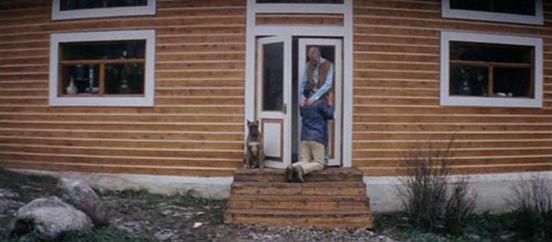 |
| Picture 11: Return home. |
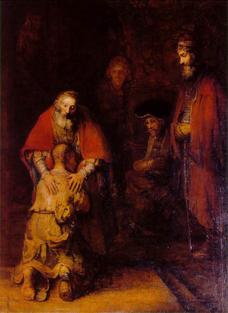 |
| Picture 12: Rembrandt’s Prodigal Son. |
It looks like a return to home, but with the next shot from above (again Bruegel’s strategy) the house and the landscape around happen to be a small island in the Solaris ocean, like an island of memory.
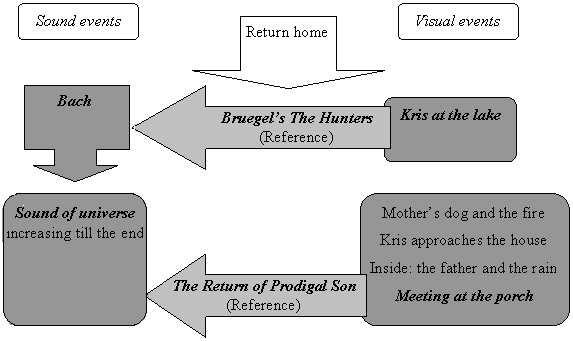
Table 3: The music-visual synchronisation of the third episode.
Thus, the following conclusions can be drawn:
- The signification process in Solaris implies the strong interaction between the musical, more generally, sound, and visual formations.
- The formations are based on symbolization and constructed as a set of quotations.
- Some of the motives and formations, both visual and musical, become semantic paradigms or refrains, according to Tarkovsky, and provide cross-references, acting as parallel but cognitively complementary fields.
- The comprehension process, thus, runs as cognitive stereoscopy and the image is received through the reflection of one image in another one or refraction of one image through another. The visuals and music interact to create plenitude.
- Comparably to metaphysical change of nature of things, Tarkovsky’s objects leave their density, constitution and consistence and percolate through, growing into each other by means of what he called poetic logic,, which creates associative links and connotations and defines the relationship of metaphors.
- By this accumulation and inter-circulation of metaphors there comes the multidimensional vision of a subject and the narrative reality doubles and trebles on having a branching structure.
- All together the metaphoric texts build up the fundamental cognitive textual channel of the film, which functions independently: those texts form a narrative line, which unfolds in parallel and through the main film narration.
Notes:
- On describing the plot here I hold to the cinematic version of it[§]
- For instance: a cosmic journey in the cosmic space, the activity in other planet, an interaction with an alien (the other world) and the scientific framework built up to support the fiction. [§]
- Here by images I mean both visual and sound representations. [§]
- It is generally known that the rain storm’ and flowing water’ motives are very typical for Tarkovsky.[§]
- The segmentation of the video to the motives shown in this table is important because of the connotative meaning, which some of these motives obtain, or their farther independent paradigmatic circulation irrelative of the whole video. Some connotations of Bruegel’s The Hunters within the film, including that of the video, marked in the table, are pointed out in the observations of the second and third music-visual episodes. [§]
Reference:
Tarkovsky, A. (1989). Sculpting in Time. Reflections on the Cinema. Austin, TX: University of Texas Press.
Subir >









